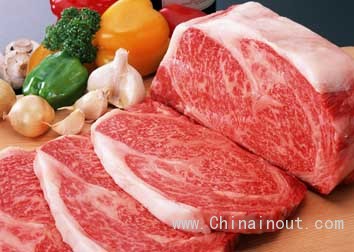根據發達國家經濟發展的規律,當一個國家人均GDP達到 1000美元時,牛肉消費會逐步增加,達到1500美元時,牛肉的消費將會大幅增加。2005年我國人均GDP達到1090美元,2008年人均GDP達到1700美元,我國或已進入牛肉消費需求的快速增長期。
受國內消費環境的影響,牛肉需求量不斷增加,而肉牛總量相對短缺,供需的不平衡推高了價格。隨著人們生活水平的提高,我國牛肉消費量越來越大,導致國內牛肉價格一路走高。相較于國內龐大的消費群體,我國牛肉產能相對不足,只能依靠大批量的進口牛肉來填補國內市場的空缺。
雖然進口牛肉的產地較多,但由于冷鮮肉和冷凍肉的保存環境有差異,出于食用安全考慮,我國一般進口冷凍肉。據海關信息網統計,2012年我國進口凍牛肉30.3萬噸,同比增長2.1倍;2013年進口141.4萬噸,同比大幅增長3.7倍;今年前7月我國進口凍牛肉91.6萬噸,同比增長27.8%。
澳洲以“綠色無污染”的聲譽使其成為我國最大的牛肉供應市場。我國已是澳大利亞最大的貿易伙伴和出口市場。
今年前7月,我國牛肉供應偏緊,凍牛肉進口持續增長,進口量達到18.3萬噸,比去年同期增長27.8%;進口均價為4338.9美元/噸,同比小幅增長2.8%。其中從澳大利亞進口牛肉8.5萬噸,同比增長32.5%,進口均價為4660.7美元/噸,同比微增2.6%,進口量占同期我國凍牛肉進口總量的46.7%。進口量排名第二位和第三位的是烏拉圭和新西蘭,進口量分別為5.1萬噸和2.9萬噸,同比分別增長33.4%和11.7%,分別占同期我國凍牛肉進口總量的28.1%和15.6%。(中國進出口網整理翻譯)

According to the laws of economic development in developed countries, when a country's AGDP reaches $1,000, beef consumption will gradually increase, when a country's AGDP reaches $1,500, the consumption of beef will increase substantially. In 2005 China's AGDP reached $1,090, in 2008 it reached $1,700, China may have entered a period - consumer’s demand for beef rapidly grows.
Affected by domestic consumption environment, the demand for beef is increasing, moreover total beef cattle is relatively in short, the imbalance between supply and demand has pushed up prices. With the improvement of people's living standards, consumption of beef is growing, domestic beef price is climbing higher and higher. Compared with the huge domestic consumer groups, beef production is relatively in lack, China can only rely on importing beef in large quantities to fill the domestic market.
Although there are many origins China can import beef, due to differences between the cold meat preservation and frozen meat preservation, in order to ensure food safety, China generally imports frozen meat. According to the statistics from Customs Information Network, in 2012 China imported 303,000 tons of frozen beef, increasing 2.1 times from one year earlier; in 2013 China imported 1.414 million tons, up 3.7 times; in the first seven months this year, China imported 916,000 tons of frozen beef , an increase of 27.8% from the same period last year.
Australia is famous for "green clean", which makes it China's largest beef supply market. China has been Australia's largest trading partner and export market.
In the first seven months this year, China's beef supply is tight, frozen beef imports continued to grow and reached 183,000 tons, an increase of 27.8% from the same period last year; import price is $4,338.9 / ton, a slight increase of 2.8 percent year on year. China imported 85,000 tons of beef from Australia, an increase of 32.5%, the average import price is $4,660.7 / ton, slightly up 2.6%, imports from Australia accounted 46.7% of total imports of beef imports. Uruguay and New Zealand ranked second and third, imports were 51,000 tons and 29,000 tons, an increase of 33.4% and 11.7% from the same period last year, accounting for 28.1% and 15.6% of total beef imports.
受國內消費環境的影響,牛肉需求量不斷增加,而肉牛總量相對短缺,供需的不平衡推高了價格。隨著人們生活水平的提高,我國牛肉消費量越來越大,導致國內牛肉價格一路走高。相較于國內龐大的消費群體,我國牛肉產能相對不足,只能依靠大批量的進口牛肉來填補國內市場的空缺。
雖然進口牛肉的產地較多,但由于冷鮮肉和冷凍肉的保存環境有差異,出于食用安全考慮,我國一般進口冷凍肉。據海關信息網統計,2012年我國進口凍牛肉30.3萬噸,同比增長2.1倍;2013年進口141.4萬噸,同比大幅增長3.7倍;今年前7月我國進口凍牛肉91.6萬噸,同比增長27.8%。
澳洲以“綠色無污染”的聲譽使其成為我國最大的牛肉供應市場。我國已是澳大利亞最大的貿易伙伴和出口市場。
今年前7月,我國牛肉供應偏緊,凍牛肉進口持續增長,進口量達到18.3萬噸,比去年同期增長27.8%;進口均價為4338.9美元/噸,同比小幅增長2.8%。其中從澳大利亞進口牛肉8.5萬噸,同比增長32.5%,進口均價為4660.7美元/噸,同比微增2.6%,進口量占同期我國凍牛肉進口總量的46.7%。進口量排名第二位和第三位的是烏拉圭和新西蘭,進口量分別為5.1萬噸和2.9萬噸,同比分別增長33.4%和11.7%,分別占同期我國凍牛肉進口總量的28.1%和15.6%。(中國進出口網整理翻譯)

According to the laws of economic development in developed countries, when a country's AGDP reaches $1,000, beef consumption will gradually increase, when a country's AGDP reaches $1,500, the consumption of beef will increase substantially. In 2005 China's AGDP reached $1,090, in 2008 it reached $1,700, China may have entered a period - consumer’s demand for beef rapidly grows.
Affected by domestic consumption environment, the demand for beef is increasing, moreover total beef cattle is relatively in short, the imbalance between supply and demand has pushed up prices. With the improvement of people's living standards, consumption of beef is growing, domestic beef price is climbing higher and higher. Compared with the huge domestic consumer groups, beef production is relatively in lack, China can only rely on importing beef in large quantities to fill the domestic market.
Although there are many origins China can import beef, due to differences between the cold meat preservation and frozen meat preservation, in order to ensure food safety, China generally imports frozen meat. According to the statistics from Customs Information Network, in 2012 China imported 303,000 tons of frozen beef, increasing 2.1 times from one year earlier; in 2013 China imported 1.414 million tons, up 3.7 times; in the first seven months this year, China imported 916,000 tons of frozen beef , an increase of 27.8% from the same period last year.
Australia is famous for "green clean", which makes it China's largest beef supply market. China has been Australia's largest trading partner and export market.
In the first seven months this year, China's beef supply is tight, frozen beef imports continued to grow and reached 183,000 tons, an increase of 27.8% from the same period last year; import price is $4,338.9 / ton, a slight increase of 2.8 percent year on year. China imported 85,000 tons of beef from Australia, an increase of 32.5%, the average import price is $4,660.7 / ton, slightly up 2.6%, imports from Australia accounted 46.7% of total imports of beef imports. Uruguay and New Zealand ranked second and third, imports were 51,000 tons and 29,000 tons, an increase of 33.4% and 11.7% from the same period last year, accounting for 28.1% and 15.6% of total beef imports.











